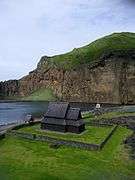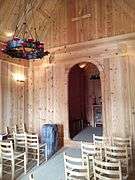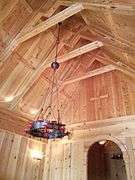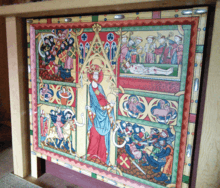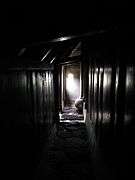Heimaey stave church
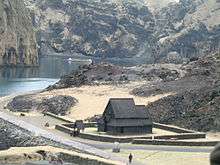
Heimaey stave church
Heimaey stave church is a close replica of Haltdalen stave church situated in the Skansinn area of the harbour of Vestmannaeyjabær on Heimaey, Vestmannaeyjar, Iceland.
In commemoration of the thousandth anniversary of the conversion of Iceland to Christianity, recalling the first church built in Iceland by Olav Tryggvason in 1000, and developing a suggestion by the Icelandic government, the Norwegian state presented Iceland with a replica of the Haltdalen stave church, originally from around the 1170s. The first church known on Iceland was a post church and not a stave church. It was built in the north in the harbour by Hjalti and Gissur, two of Olav Tryggvason’s men. That church is long gone together with a number of other churches, some which are known to have been even larger than those found in Norway today.
The replica was erected by the harbour of Vestmannaeyjabær in the Vestmannaeyjar, in an area formed by the lava of the 1973 eruption of Eldfell. The replica was undertaken by the Norwegian Institute for Cultural Heritage Research as a three-year research and reconstruction project from 1998 to 2000 under the leadership of Elisabeth Seip. The church was constructed at Lom from materials deliberately drawn widely from around Norway, including timber from Røros, shingles from Odalen, tar from Skjåk, wrought iron from Vågå, and a doorstep from Holtålen. A gallery was added around the outside of the building, inspired by other stave churches, to provide the building with extra strength against the stormy weather of the Vestmannaeyjar. The church was built and consecrated in summer 2000, and was completed on 30 July 2000. The project was supported by a Norwegian government grant of 5.5m Norwegian kroner; Icelandic government funding for the redevelopment of the Skansinn area of Vestmannaeyjarbær as a heritage area; and some private sponsorship was also involved, most importantly that the Icelandic company Eimskip shipped the church to Iceland for free.[1]
The replica also includes an altar decorated with a replica of the St Olav frontal, one of the finest surviving medieval Norwegian works of art, undertaken under the leadership of Terje Nordsted. The original for this is at Nidaros Cathedral but is said (without any substantial supporting evidence) once to have been situated in the Haltdalen stave church.[2]
| Heimaey Stave Church (replica of the Haltdalen Stave Church) |
|---|
| Replica of Haltdalen Stave Church in situ. |
| Nave of the church, showing entrance to the choir. |
| Outer gallery, not in the original church. |
|
External links
Coordinates: 63°26′39″N 20°15′40″W / 63.4443°N 20.2612°W / 63.4443; -20.2612
References
- ↑ Paul Torvik Nilsen, 'Colourful Middle Ages', Tell'us: Science in Norway (December 2001), 6-9.
- ↑ Paul Torvik Nilsen, 'Colourful Middle Ages', Tell'us: Science in Norway (December 2001), 8-9.

